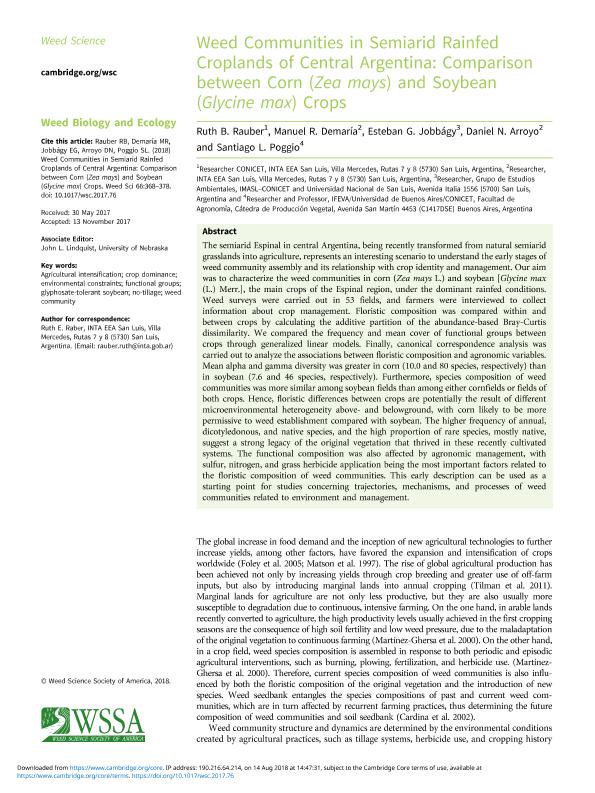Artículo
Weed Communities in Semiarid Rainfed Croplands of Central Argentina: Comparison between Corn (Zea mays) and Soybean (Glycine max) Crops
Rauber, Ruth Bibiana ; Demaría, Manuel R.; Jobbagy Gampel, Esteban Gabriel
; Demaría, Manuel R.; Jobbagy Gampel, Esteban Gabriel ; Arroyo, Daniel N.; Poggio, Santiago Luis
; Arroyo, Daniel N.; Poggio, Santiago Luis
 ; Demaría, Manuel R.; Jobbagy Gampel, Esteban Gabriel
; Demaría, Manuel R.; Jobbagy Gampel, Esteban Gabriel ; Arroyo, Daniel N.; Poggio, Santiago Luis
; Arroyo, Daniel N.; Poggio, Santiago Luis
Fecha de publicación:
05/2018
Editorial:
Weed Science Society of America
Revista:
Weed Science
ISSN:
0043-1745
Idioma:
Inglés
Tipo de recurso:
Artículo publicado
Clasificación temática:
Resumen
The semiarid Espinal in central Argentina, being recently transformed from natural semiarid grasslands into agriculture, represents an interesting scenario to understand the early stages of weed community assembly and its relationship with crop identity and management. Our aim was to characterize the weed communities in corn (Zea mays L.) and soybean [Glycine max (L.) Merr.], the main crops of the Espinal region, under the dominant rainfed conditions. Weed surveys were carried out in 53 fields, and farmers were interviewed to collect information about crop management. Floristic composition was compared within and between crops by calculating the additive partition of the abundance-based Bray-Curtis dissimilarity. We compared the frequency and mean cover of functional groups between crops through generalized linear models. Finally, canonical correspondence analysis was carried out to analyze the associations between floristic composition and agronomic variables. Mean alpha and gamma diversity was greater in corn (10.0 and 80 species, respectively) than in soybean (7.6 and 46 species, respectively). Furthermore, species composition of weed communities was more similar among soybean fields than among either cornfields or fields of both crops. Hence, floristic differences between crops are potentially the result of different microenvironmental heterogeneity above- and belowground, with corn likely to be more permissive to weed establishment compared with soybean. The higher frequency of annual, dicotyledonous, and native species, and the high proportion of rare species, mostly native, suggest a strong legacy of the original vegetation that thrived in these recently cultivated systems. The functional composition was also affected by agronomic management, with sulfur, nitrogen, and grass herbicide application being the most important factors related to the floristic composition of weed communities. This early description can be used as a starting point for studies concerning trajectories, mechanisms, and processes of weed communities related to environment and management.
Archivos asociados
Licencia
Identificadores
Colecciones
Articulos(CCT - SAN LUIS)
Articulos de CTRO.CIENTIFICO TECNOL.CONICET - SAN LUIS
Articulos de CTRO.CIENTIFICO TECNOL.CONICET - SAN LUIS
Articulos(IFEVA)
Articulos de INST.D/INV.FISIOLOGICAS Y ECO.VINCULADAS A L/AGRIC
Articulos de INST.D/INV.FISIOLOGICAS Y ECO.VINCULADAS A L/AGRIC
Articulos(IMASL)
Articulos de INST. DE MATEMATICA APLICADA DE SAN LUIS
Articulos de INST. DE MATEMATICA APLICADA DE SAN LUIS
Citación
Rauber, Ruth Bibiana; Demaría, Manuel R.; Jobbagy Gampel, Esteban Gabriel; Arroyo, Daniel N.; Poggio, Santiago Luis; Weed Communities in Semiarid Rainfed Croplands of Central Argentina: Comparison between Corn (Zea mays) and Soybean (Glycine max) Crops; Weed Science Society of America; Weed Science; 66; 3; 5-2018; 368-378
Compartir
Altmétricas



